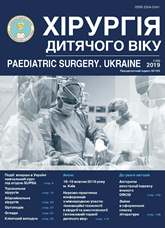Complex treatment of the first year of life children with hip joints dysplasia
DOI:
https://doi.org/10.15574/PS.2019.63.57Keywords:
children, dysplasia of hip joints, treatmentAbstract
Dysplasia of hip joints (DHJ) is one of the leading states among diseases of the musculoskeletal system and in recent years has increased to 100 – 200 cases per 1000 newborns.
Objective: to increase the efficiency of rehabilitation treatment of first year of life children with dysplasia of hip joints by differentiated use of medical physical factors depending on peculiarities of the disease course and the associated pathology.
Materials and methods. We have supervised 215 patients aged 1 to 8 months with DHJ; 168 girls (78.1%), 47 boys (21.9%). The average age of patients was (105.6±38.8) days. 147 (68.4%) children with DHJ had a concomitant pathology in the form of perinatal lesions of the central nervous system or connective tissue dysplasia; only 68 (31.6%) patients had DHJ without a concomitant pathology.
Research results. The inclusion of low frequency magnetotherapy to traditional treatment (orthopedic remedies, therapeutic exercises, massage, UHF therapy, electrophoresis of calcium chloride) of children with DHJ helped to reduce the duration of treatment on 1.5–2 months and to increase the effectiveness of treatment to 13.8–19.4% depending on the degree of DHJ. Additional inclusion of laser therapy to the developed complex for children with II-III degree DHJ increased the effectiveness of treatment by 16.2% and shortened the duration of positional therapy on 3 months. The combined use of magnetotherapy, laser therapy and sodium chloride baths against the background of traditional treatment of children with DHJ increased the effectiveness of treatment by 15.7% and shortened its duration by 2 months.
Conclusion. The use of developed therapeutic and rehabilitation complexes, which include orthopedic means, therapeutic exercises, massage and differentiated physiotherapy can increase the effectiveness of treatment for children with dysplasia of hip joints on (16.6±0.6)%, reduce the duration of treatment, increase the number of good results in 2.8 times (from 28.5% to 79.1%), reduce the number of satisfactory results to 5.0%.
References
Voloshin SY, Belousova EA. (2015). Features rehabilitation of infants with congenital hip dislocation on the stages of conservative treatment. Pediatric Traumatology, Orthopaedics and Reconstructive Surgery.. 3(2):66–70. https://doi.org/10.17816/PTORS3266-70
Kamosko MM, Poznovich MS. (2014). Conservative treatment of hip dysplasia. Pediatric Traumatology, Orthopaedics and Reconstructive Surgery. 2(4):51–50. https://doi.org/10.17816/PTORS2451-60
Lukash YV, Shamik VB. (2012). Early diagnostics dysplasia of the hip in the newborns. Sovremennye problemy nauki i obrazovaniya. 6: www.science-education.ru/106-7908
Pozdnikin IYu, Baskov VE, Voloshin SYu, Barsukov DB, Krasnov AI, Poznovich MS. et al. (2017). Errors of diagnosis and the initiation of conservative treatment in children with congenital hip dislocation. Pediatric Traumatology, Orthopaedics and Reconstructive Surgery. 5(2):42–51. https://doi.org/10.17816/PTORS5242-51
Rumyantseva GN, Rasskazov LV, Kartashev VN, Ivanov YUN, Murga VV. (2013). Formation of the pathology of the skeletal system in undifferentiated forms of connective tissue dysplasia. Pediatricheskie aspekty displazii soedinitel'noj tkani. Dostizheniya i perspektivy. Moskva – Tver' – Sankt-Peterburg. Rossijskij sbornik nauchnykh trudov s mezhdunarodnym uchastiem. 3:100–106.
Aarvold A, Schaeffer EK, Kelley S, Clarke N, Herrera-Soto JA, Price CT, Mulpuri K, IHDI Study Group. (2018). Management of Irreducible Hip Dislocations in Infants With Developmental Dysplasia of the Hip Diagnosed Below 6 Months of Age. Journal of pediatric orthopedics. 39(1):e39-e43. https://doi.org/10.1097/BPO.0000000000001205; PMid:30212414 PMCid:PMC6310453
Alassaf N. (2018). Predictors of femoral shortening for pediatric developmental hip dysplasia surgery: an observational study in 435 patients. Patient safety in surgery. 12(29). https://doi.org/10.1186/s13037-018-0176-y; PMid:30377448 PMCid:PMC6194737
Atalar H, Dogruel H, Selek H, Adil TB, Bicimoglu A, Gunay C. (2013). A comparison of ultrasonography and radiography in the management of infants with suspected developmental dysplasia of the hip. Acta Orthop. Belg. 79:524–529.
Zhou Y, Ju L, Lou Y, & Wang B. (2019). Analysis of acetabulum in children with developmental dysplasia of the hip by MRI scan. Medicine. 98(3):e14054. https://doi.org/10.1097/MD.0000000000014054; PMid:30653114 PMCid:PMC6370164
Downloads
Issue
Section
License
The policy of the Journal “PAEDIATRIC SURGERY. UKRAINE” is compatible with the vast majority of funders' of open access and self-archiving policies. The journal provides immediate open access route being convinced that everyone – not only scientists - can benefit from research results, and publishes articles exclusively under open access distribution, with a Creative Commons Attribution-Noncommercial 4.0 international license(СС BY-NC).
Authors transfer the copyright to the Journal “PAEDIATRIC SURGERY.UKRAINE” when the manuscript is accepted for publication. Authors declare that this manuscript has not been published nor is under simultaneous consideration for publication elsewhere. After publication, the articles become freely available on-line to the public.
Readers have the right to use, distribute, and reproduce articles in any medium, provided the articles and the journal are properly cited.
The use of published materials for commercial purposes is strongly prohibited.

